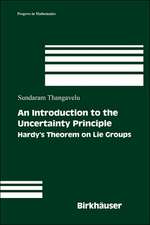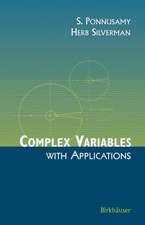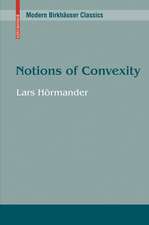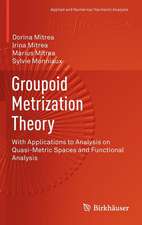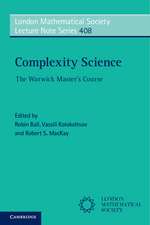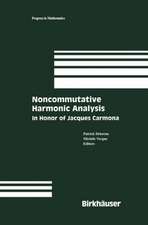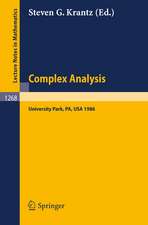Explorations in Harmonic Analysis: With Applications to Complex Function Theory and the Heisenberg Group: Applied and Numerical Harmonic Analysis
Autor Steven G. Krantzen Limba Engleză Hardback – 5 mai 2009
Din seria Applied and Numerical Harmonic Analysis
-
 Preț: 399.29 lei
Preț: 399.29 lei -
 Preț: 310.86 lei
Preț: 310.86 lei - 19%
 Preț: 443.08 lei
Preț: 443.08 lei - 20%
 Preț: 673.02 lei
Preț: 673.02 lei - 17%
 Preț: 431.76 lei
Preț: 431.76 lei -
 Preț: 412.57 lei
Preț: 412.57 lei - 15%
 Preț: 550.04 lei
Preț: 550.04 lei - 15%
 Preț: 653.98 lei
Preț: 653.98 lei - 18%
 Preț: 1014.28 lei
Preț: 1014.28 lei - 15%
 Preț: 647.92 lei
Preț: 647.92 lei -
 Preț: 413.37 lei
Preț: 413.37 lei - 15%
 Preț: 532.89 lei
Preț: 532.89 lei - 15%
 Preț: 646.62 lei
Preț: 646.62 lei - 15%
 Preț: 653.98 lei
Preț: 653.98 lei -
 Preț: 397.38 lei
Preț: 397.38 lei - 15%
 Preț: 656.43 lei
Preț: 656.43 lei - 15%
 Preț: 661.97 lei
Preț: 661.97 lei - 24%
 Preț: 829.71 lei
Preț: 829.71 lei - 18%
 Preț: 957.13 lei
Preț: 957.13 lei - 15%
 Preț: 648.74 lei
Preț: 648.74 lei - 15%
 Preț: 654.77 lei
Preț: 654.77 lei - 15%
 Preț: 636.80 lei
Preț: 636.80 lei -
 Preț: 398.35 lei
Preț: 398.35 lei - 20%
 Preț: 569.85 lei
Preț: 569.85 lei -
 Preț: 392.21 lei
Preț: 392.21 lei - 18%
 Preț: 1121.76 lei
Preț: 1121.76 lei -
 Preț: 387.75 lei
Preț: 387.75 lei - 18%
 Preț: 1006.72 lei
Preț: 1006.72 lei - 20%
 Preț: 567.32 lei
Preț: 567.32 lei - 20%
 Preț: 573.76 lei
Preț: 573.76 lei -
 Preț: 406.80 lei
Preț: 406.80 lei -
 Preț: 387.38 lei
Preț: 387.38 lei - 5%
 Preț: 1168.71 lei
Preț: 1168.71 lei -
 Preț: 400.85 lei
Preț: 400.85 lei -
 Preț: 398.15 lei
Preț: 398.15 lei - 15%
 Preț: 644.49 lei
Preț: 644.49 lei - 19%
 Preț: 575.82 lei
Preț: 575.82 lei - 15%
 Preț: 703.71 lei
Preț: 703.71 lei - 20%
 Preț: 334.71 lei
Preț: 334.71 lei - 15%
 Preț: 525.54 lei
Preț: 525.54 lei -
 Preț: 405.06 lei
Preț: 405.06 lei - 15%
 Preț: 536.96 lei
Preț: 536.96 lei
Preț: 400.26 lei
Nou
Puncte Express: 600
Preț estimativ în valută:
76.62€ • 78.85$ • 64.59£
76.62€ • 78.85$ • 64.59£
Carte tipărită la comandă
Livrare economică 01-15 martie
Preluare comenzi: 021 569.72.76
Specificații
ISBN-13: 9780817646684
ISBN-10: 081764668X
Pagini: 362
Ilustrații: XIV, 362 p.
Dimensiuni: 155 x 235 x 22 mm
Greutate: 0.7 kg
Ediția:2009
Editura: Birkhäuser Boston
Colecția Birkhäuser
Seria Applied and Numerical Harmonic Analysis
Locul publicării:Boston, MA, United States
ISBN-10: 081764668X
Pagini: 362
Ilustrații: XIV, 362 p.
Dimensiuni: 155 x 235 x 22 mm
Greutate: 0.7 kg
Ediția:2009
Editura: Birkhäuser Boston
Colecția Birkhäuser
Seria Applied and Numerical Harmonic Analysis
Locul publicării:Boston, MA, United States
Public țintă
GraduateCuprins
Ontology and History of Real Analysis.- The Central Idea: The Hilbert Transform.- Essentials of the Fourier Transform.- Fractional and Singular Integrals.- A Crash Course in Several Complex Variables.- Pseudoconvexity and Domains of Holomorphy.- Canonical Complex Integral Operators.- Hardy Spaces Old and New.- to the Heisenberg Group.- Analysis on the Heisenberg Group.- A Coda on Domains of Finite Type.
Recenzii
From the reviews:
“This is an ambitious introduction to a particular direction in modern harmonic analysis. It presents harmonic analysis in vitro – in a context in which it is actually applied complex variables and partial differential equations. This will make the learning experience more meaningful for graduate students who are just beginning to forge a path of research.” (Vasily A. Chernecky, Zentralblatt MATH, Vol. 1171, 2009)
“Writing a 350 page account on harmonic analysis … is no easy task and making the presentation suitable for graduate students even less so. … it is indeed the purpose of the book under review … . Krantz has done an admirable job in condensing the ideas of Stein’s tract into a highly readily text suitable for a wide variety of readers. … It is done with such an enthusiasm … that even seasoned mathematicians should be able to enjoy the book.” (Troels Roussau Johansen, Mathematical Reviews, Issue 2011 a)
“The text is very well organized: each chapter begins with an introductory Prologue, each section with a Capsule giving a quick preview of the material, and each key theorem is preceded by a Prelude providing motivation and putting the result in an adequate context. … The book will be useful for advanced courses on harmonic analysis, singular integrals, as well as reference text for researchers in various domains of analysis, both pure and applied.” (Gabriela Kohr, Studia Universitatis Babes-Bolyai, Mathematica, Vol. LV (4), December, 2010)
“This is an ambitious introduction to a particular direction in modern harmonic analysis. It presents harmonic analysis in vitro – in a context in which it is actually applied complex variables and partial differential equations. This will make the learning experience more meaningful for graduate students who are just beginning to forge a path of research.” (Vasily A. Chernecky, Zentralblatt MATH, Vol. 1171, 2009)
“Writing a 350 page account on harmonic analysis … is no easy task and making the presentation suitable for graduate students even less so. … it is indeed the purpose of the book under review … . Krantz has done an admirable job in condensing the ideas of Stein’s tract into a highly readily text suitable for a wide variety of readers. … It is done with such an enthusiasm … that even seasoned mathematicians should be able to enjoy the book.” (Troels Roussau Johansen, Mathematical Reviews, Issue 2011 a)
“The text is very well organized: each chapter begins with an introductory Prologue, each section with a Capsule giving a quick preview of the material, and each key theorem is preceded by a Prelude providing motivation and putting the result in an adequate context. … The book will be useful for advanced courses on harmonic analysis, singular integrals, as well as reference text for researchers in various domains of analysis, both pure and applied.” (Gabriela Kohr, Studia Universitatis Babes-Bolyai, Mathematica, Vol. LV (4), December, 2010)
Textul de pe ultima copertă
This self-contained text provides an introduction to modern harmonic analysis in the context in which it is actually applied, in particular, through complex function theory and partial differential equations. It takes the novice mathematical reader from the rudiments of harmonic analysis (Fourier series) to the Fourier transform, pseudodifferential operators, and finally to Heisenberg analysis.
Within the textbook, the new ideas on the Heisenberg group are applied to the study of estimates for both the Szegö and Poisson–Szegö integrals on the unit ball in complex space. Thus the main theme of the book is also tied into complex analysis of several variables. With a rigorous but well-paced exposition, this text provides all the necessary background in singular and fractional integrals, as well as Hardy spaces and the function theory of several complex variables, needed to understand Heisenberg analysis.
Explorations in Harmonic Analysis is ideal for graduate students in mathematics, physics, and engineering. Prerequisites include a fundamental background in real and complex analysis and some exposure to functional analysis.
Within the textbook, the new ideas on the Heisenberg group are applied to the study of estimates for both the Szegö and Poisson–Szegö integrals on the unit ball in complex space. Thus the main theme of the book is also tied into complex analysis of several variables. With a rigorous but well-paced exposition, this text provides all the necessary background in singular and fractional integrals, as well as Hardy spaces and the function theory of several complex variables, needed to understand Heisenberg analysis.
Explorations in Harmonic Analysis is ideal for graduate students in mathematics, physics, and engineering. Prerequisites include a fundamental background in real and complex analysis and some exposure to functional analysis.
Caracteristici
Provides an introduction to a particular direction in modern harmonic analysis Self-contained text on analysis of integral operators Presents both fundamentals and applications of harmonic analysis, especially to important concepts about the Heisenberg group Includes supplementary material: sn.pub/extras




